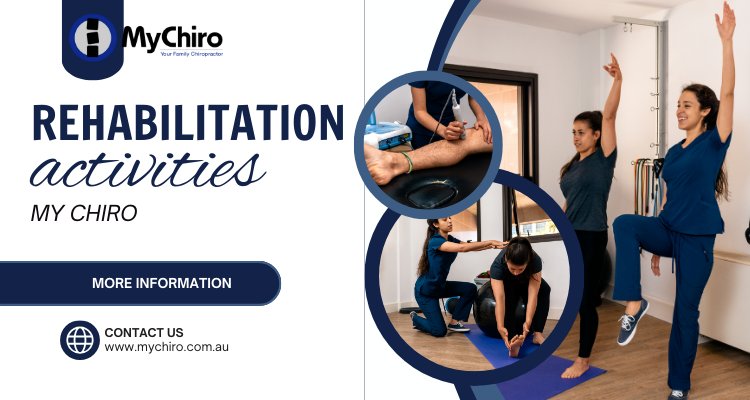Comprehensive Guide to Rehabilitation Activities
Rehabilitation Activities
Share this Post to earn Money ( Upto ₹100 per 1000 Views )

At My Chiro, we understand the importance of comprehensive rehabilitation activities to ensure a smooth and effective recovery process. Whether you're recovering from an injury, surgery, or managing a chronic condition, our tailored rehabilitation programs are designed to restore function, improve mobility, and enhance your overall quality of life. Below, we delve into various rehabilitation activities that can significantly benefit your recovery journey.
Understanding Rehabilitation
Rehabilitation is a holistic approach to recovery that encompasses physical, emotional, and social aspects. It involves various therapeutic activities aimed at restoring maximum function and independence. At My Chiro, our rehabilitation specialists work closely with each patient to develop a personalized plan that addresses their specific needs and goals.
Physical Rehabilitation Activities
1. Strength Training
Strength training is a cornerstone of physical rehabilitation. It involves exercises designed to increase muscle strength, improve joint stability, and enhance overall endurance. Common strength training activities include:
- Resistance Band Exercises: Using resistance bands to perform a range of motions that target different muscle groups.
- Weight Lifting: Utilizing free weights or machines to build muscle strength.
- Bodyweight Exercises: Exercises such as squats, lunges, and push-ups that use the body's own weight for resistance.
2. Aerobic Conditioning
Aerobic conditioning, also known as cardiovascular exercise, is essential for improving heart health, increasing stamina, and promoting overall wellness. Effective aerobic activities include:
- Walking: A low-impact exercise suitable for most individuals.
- Cycling: Both stationary and outdoor cycling are excellent for building cardiovascular fitness.
- Swimming: A full-body workout that is gentle on the joints.
3. Flexibility Exercises
Maintaining and improving flexibility is crucial in rehabilitation to prevent stiffness and enhance range of motion. Key flexibility exercises include:
- Stretching: Incorporating daily stretching routines targeting all major muscle groups.
- Yoga: A practice that combines physical postures, breathing exercises, and meditation.
- Pilates: Focuses on core strength, flexibility, and overall body awareness.
Occupational Therapy Activities
Occupational therapy focuses on helping individuals regain independence in their daily activities. Key occupational therapy activities include:
1. Daily Living Skills Training
This involves teaching and practicing essential daily tasks such as:
- Dressing: Techniques to make dressing easier and safer.
- Cooking: Adapted methods for meal preparation.
- Hygiene: Ensuring patients can manage personal hygiene independently.
2. Hand Therapy
Hand therapy is crucial for those recovering from hand or wrist injuries. Activities may include:
- Fine Motor Exercises: Tasks that improve dexterity, such as buttoning shirts or manipulating small objects.
- Grip Strengthening: Using tools like stress balls or therapy putty to enhance grip strength.
3. Cognitive Rehabilitation
For patients recovering from neurological conditions, cognitive rehabilitation activities are essential. These may include:
- Memory Exercises: Activities designed to improve short-term and long-term memory.
- Problem-Solving Tasks: Games and puzzles that enhance cognitive function.
- Attention Training: Techniques to improve focus and concentration.
Speech Therapy Activities
Speech therapy is vital for individuals recovering from conditions that affect speech and communication. Essential speech therapy activities include:
1. Articulation Therapy
Articulation therapy focuses on improving the clarity of speech. Techniques include:
- Repetition Exercises: Practicing specific sounds or words repeatedly.
- Mouth Exercises: Strengthening the muscles used in speech.
2. Language Intervention
Language intervention activities aim to enhance vocabulary and language skills through:
- Reading Comprehension Exercises: Engaging with texts to improve understanding and language use.
- Conversation Practice: Structured dialogues to practice fluency and coherence.
3. Swallowing Therapy
Swallowing therapy is essential for those with dysphagia. Key activities include:
- Swallowing Exercises: Specific techniques to improve swallowing ability.
- Diet Modifications: Adjusting food textures and consistencies for safer swallowing.
Alternative Rehabilitation Activities
In addition to traditional therapies, alternative rehabilitation activities can play a significant role in recovery. These include:
1. Hydrotherapy
Hydrotherapy involves using water for therapeutic purposes. Benefits include:
- Buoyancy: Reducing stress on joints and muscles.
- Resistance: Enhancing muscle strength and endurance.
2. Acupuncture
Acupuncture, an ancient Chinese practice, can help in pain management and promote healing by:
- Stimulating Nerves: Improving nerve function and reducing pain.
- Enhancing Circulation: Promoting blood flow to affected areas.
3. Massage Therapy
Massage therapy aids in relaxation and muscle recovery. Key benefits include:
- Reducing Muscle Tension: Alleviating stress and pain in muscles.
- Improving Flexibility: Enhancing the range of motion in joints and muscles.
Psychological Rehabilitation Activities
Recovery isn't just physical; psychological well-being is equally important. Psychological rehabilitation activities include:
1. Counseling and Psychotherapy
Engaging with professional counselors can help patients manage stress, anxiety, and depression. Techniques include:
- Cognitive Behavioral Therapy (CBT): Addressing negative thought patterns and behaviors.
- Mindfulness Practices: Techniques to promote relaxation and stress reduction.
2. Support Groups
Support groups provide a sense of community and shared experience. Benefits include:
- Peer Support: Connecting with others facing similar challenges.
- Sharing Strategies: Learning effective coping mechanisms from others.
3. Recreational Therapy
Recreational therapy uses leisure activities to enhance well-being. Activities include:
- Art Therapy: Using creative expression to process emotions.
- Music Therapy: Engaging with music to promote relaxation and emotional health.
- Animal-Assisted Therapy: Interacting with animals to reduce stress and improve mood.
Customized Rehabilitation Programs at My Chiro
At My Chiro, we prioritize personalized rehabilitation programs tailored to each patient's unique needs. Our comprehensive approach includes:
- Initial Assessment: Thorough evaluation of physical, cognitive, and emotional health.
- Individualized Plan: Customized therapy plans that address specific recovery goals.
- Ongoing Monitoring: Regular assessments to track progress and adjust the plan as needed.
Conclusion
Effective rehabilitation activities are essential for a successful recovery. At My Chiro, we are dedicated to providing the highest quality care through a combination of physical, occupational, speech, and alternative therapies. Our goal is to empower patients to regain their independence, improve their quality of life, and achieve optimal recovery.
















